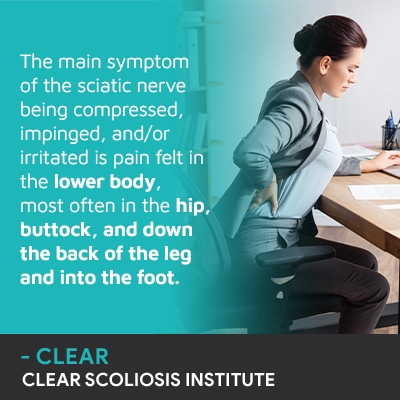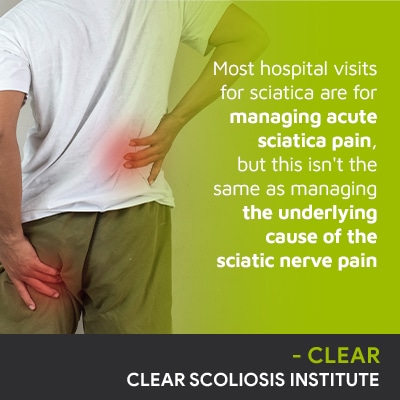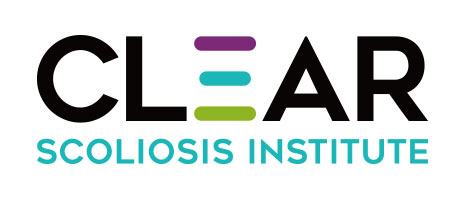
Sciatica pain can vary in severity, and when it comes to treatment, the underlying cause of the sciatic nerve pain has to be determined and addressed. Sudden sciatica pain and/or pain that persists can bring people into the Emergency room, mainly for symptom relief.
Most visits to a hospital for sciatica are for sudden and unfamiliar pain. Sciatica refers to pain and discomfort felt anywhere along the sciatic nerve's pathway, and the term doesn't indicate its cause. Hospitals mainly help with symptom management.
The sciatic nerve is the largest in the body, and when compressed, can cause a number of unpleasant symptoms.
The sciatic nerve is a large mixed nerve that starts in the lumbar spine (lower back) and projects down the buttock, leg, and into the foot.
As a mixed nerve containing both sensory and motor fibers, symptoms can involve strange sensations and mobility issues.
The sciatic nerve controls muscles in the back of the knee and lower leg and provides sensation to the back of the thigh, lower leg, and foot.
So the motor function of the nerve is to facilitate the leg and foot's mobility and its sensory role is to provide sensation in the legs.
If the sciatic nerve is compressed and/or damaged, it can cause a number of symptoms felt throughout the lower body.

In most cases, pain is felt down the left side, but it can also involve the right, and in rare cases can affect both sides of the body.
Sciatica pain can range from mild and sporadic to severe and debilitating. Oftentimes, people suffer from flare ups that involve symptoms intensifying and gradually improving.
Some patients have chronic sciatica pain, and in these types of cases, it's important to understand that it's likely not due to an injury, but can have an underlying cause.
If pain develops suddenly and abates in a number of weeks, it was likely a temporary cause like an overuse injury, and these types of cases can resolve in a number of weeks with rest.
When someone experiences severe sciatica pain for the first time and/or if pain persists and becomes unmanageable, Emergency room visits are common.

Most hospital visits will be to Emergency as symptom flare ups can be intense and involve severe pain that can cause strange sensations like numbness, tingling, sharp shooting pains throughout the lower body, muscle weakness and pain, and issues with lower body mobility.
Hospital visits commonly include a physical examination and discussing the patient's symptoms and family history.
When the pain is intense, symptom relief is the focus of a visit to the hospital, and this commonly involves pain medication and nerve blocks.
Sudden neurological symptoms can also bring people into the hospital.
If the sciatic nerve is exposed to uneven pressure and is pinched, it can also cause neurological symptoms, and the sudden appearance of neurological symptoms can be concerning and also bring people into the hospital for symptom management.
Neurological symptoms can include sudden weakness, numbness, loss of sensation in the leg and/or foot, and the genital area.
Issues with bladder and/or bowel control can also develop and bring people into the hospital in search of symptom relief and answers.
It's important that people understand, however, that hospital visits for pain and neurological symptoms are more about immediate pain relief, but not diagnosis and treatment; the first step to addressing sciatica pain for the long term is determining its underlying cause.
Common causes of sciatic nerve pain include injury, disc herniation, and underlying conditions like spinal stenosis and scoliosis.
When an overuse injury and/or strain is the cause, most cases will resolve on their own with rest.
When a herniated disc is the cause, this means a disc in the lumbar spine has had its inner material push through a tear in its outer annulus, and this causes a loss of space for its surroundings, and if it occurs near the sciatic nerve, a patient's sciatic nerve pain can develop because the disc's inner nucleus is pressing against the nerves.
Debilitating radicular pain can develop as the nerve is being exposed to constant uneven pressure, so treatment has to relieve pressure on the affected nerve by improving the health of the affected disc.
Spinal stenosis is another common cause of sciatica and involves a loss of space within the spinal canal, through which the spinal nerves pass, including the sciatic nerve.
Spinal stenosis that develops in the lumbar spine can cause the sciatic nerve to become impinged and irritated; to treat nerve pain caused by stenosis, space has to be opened up within the spine and pressure removed from the sciatic nerve.
Another underlying spinal condition that commonly causes sciatic nerve pain as a related complication is lumbar scoliosis.
Scoliosis causes the spine to bend and rotate unnaturally, and if this develops in the lumbar spine, it can introduce uneven forces to the lower spine and the nerves within.
If the sciatic nerve is compressed by a scoliosis curve, the structural nature of scoliosis has to be impacted with treatment, meaning curves need to be reduced so pressure is taken off the sciatic nerve.
So while hospital visits for sciatica can respond with immediate pain relief, this isn't the same as determining the underlying cause of the pain and customizing treatment accordingly.
So to reduce sciatica pain for the long term, its underlying cause has to be determined, and while hospitals can order emergency imaging tests like X-rays or a magnetic resonance imaging (MRI), in most cases, the focus isn't on diagnostics but on symptom management: immediate pain relief.
The focus of most busy Emergency rooms is to move patients through, not to detain them for long periods of time during complex diagnostic exams and awaiting results.
Sciatica nerve compression can cause excruciating pain that requires immediate relief, and this is most effectively achieved through pain relief medications and epidural lumbar steroid injections.
Treating sciatica for the long term involves assessment, diagnosis, and treatment plan customization.
While a hospital visit can help with immediate pain relief, sciatic nerve compression with an underlying cause requires proactive treatment that requires more time.
The most common cause of sciatic nerve pain involves the discs that sit between adjacent vertebrae; if one or more starts to degenerate and change shape, it can compress he sciatic nerve and cause a variety of symptoms.
Degenerative disc disease is one of the main causes of spinal degeneration and can affect the spine and its surroundings in a number of ways.
Treatment for disc issues can involve in office physical therapy to help improve blood flow needed by the discs to repair.
If the nerve is compressed due to a spinal condition like stenosis or scoliosis, the condition itself has to be the focus of treatment as the sciatica pain develops as a related complication.
Here at the CLEAR Scoliosis Institute, spinal health is preserved by applying proactive conservative treatment to a variety of spinal conditions/issues, sciatica pain included.

CLEAR provides a unique and innovative way of understanding scoliosis. Sign up to receive facts and information you won’t find anywhere else.
